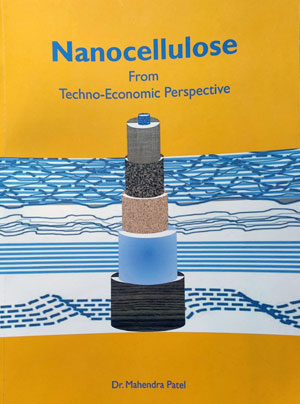| Nanocellulose from Techno-economic Perspective |
| |
| Nanocellulose from Techno-economic Perspective |
| |
Author: Dr Mahendra Patel, Publisher: Industrypaper, New Delhi & Sambalpur (India)
Pages: 560; ISBN No.: 978-81-923542-7-9, Publ. on 10th March 2022
|
| |
|
Nanocellulose is gradually gaining prominence because of its property-enhancing ability as a super additive in a large number of products; notably paper and packaging, food, medicine, composite materials, cosmetics, textile, energy and electronics and in many other materials. Nanocellulose-based composite materials find applications in the medical for artificial organs etc., as nanocellulose is biocompatible. The possibility of its use as antimicrobial material to combat the Corona virus has recently been advocated and if the technology can be advanced, it will be of immense service to the society.
|
| |
 |
The number of publications and patents on nanocellulose has been rising every year as it is fairly a new product and it gives charismatic properties on addition to various materials. The impetus to assured development of new products with enhanced performance of nanocellulose emanates from the facts that nanocellulose is produced from abundantly available renewable plant materials; it is biocompatible and environmentally benign with ability to replace the fossil-based petro-chemical products.
Product quality and processing ease as well as environmental benignity and financial benefit of an industry depends to a major extent on the raw materials used and techniques of processing them to obtain the product. Availability, cost and biodegradability of the raw material have bearing on the techno-economic viability of the technology employed. Though industrial production of nanocellulose has commenced and capacities are increasing, the best available technology and raw material are still on the search. Techno-economically viable raw materials and production technology for effective and wide- scale applications are yet to be sorted out; an integrated system remains to be addressed.
|
|
| |
This book addresses the techno-economic aspects of nanocellulose production. Raw materials account for 40-70% of the total cost of nanocellulose production at industrial scale and thus governs the techno-economics. This book discusses on the vital issue of techno-economics starting from the individual raw material to processing technologies.
There are as such more than forty different raw materials discussed in this book, apart from different trees and industrial as well as agricultural wastes, produced in small volumes. The papermaking fibres, namely wood, agro-residues and recycled fibre are discussed elaborately in this book, considering the techno-economic implications of the papermaking fibres in nanocellulose production at industrial scale. The raw materials are discussed in the six different sections and 22 chapters encompassing forty different raw materials.
Raw Materials with Processing technologies for producing Nanocellulose including flow diagrams, techno-economics, availability of raw materials, present uses, pulping and bleaching etc are discussed starting from the raw material. The book has the novelty in assessing the raw materials and processing technologies in terms of techno-economics in industrial production of nanocellulose for mass scale applications. Ample of case studies with experimental details, fundamentals on the plant and cellulose molecular structure as well as nanocellulose particle characterisation in this book, will enable the researchers and producers to have an integrated and in-depth knowledge on the production process. Subject of bioeconomy, biorefinery, enzymatic hydrolysis of different feed stocks in bioenergy production, has also been incorporated in many raw materials.
|
|
|